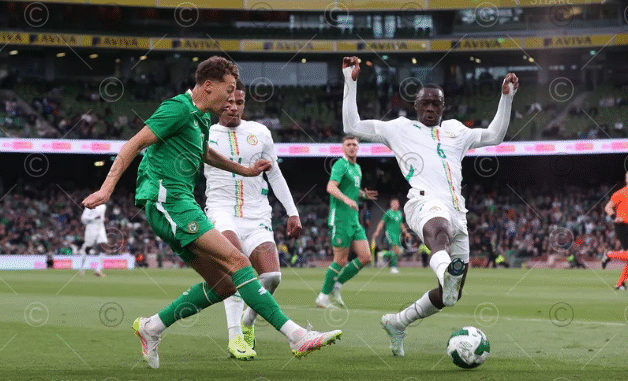
Sunderland are on the verge of making a significant statement in the transfer market, closing in on a club-record £30 million deal to sign Habib Diarra from RC Strasbourg. If the move is completed, Diarra will become the most expensive player in the club’s history. The Senegalese international is expected to undergo his medical in the coming days, with Sunderland fans already drawing comparisons between him and Jobe Bellingham—the highly rated midfielder Diarra is poised to replace. Both players are under 21, operate as athletic box-to-box midfielders, and were deployed in similar roles last season: Bellingham on the left in the Championship, Diarra on the right in Ligue 1 under Liam Rosenior. But do the stats suggest Sunderland are getting an upgrade?
When it comes to goal threat and attacking output, Diarra edges ahead. In 38 Ligue 1 matches, he scored seven goals across 2,969 minutes, averaging 0.21 goals per 90 minutes. Bellingham, meanwhile, managed five goals in 46 Championship appearances (4,363 minutes), with an average of just 0.10 goals per 90. Diarra also took more shots per game (1.97) and had a slightly better conversion rate (9.0%) than Bellingham’s 7.7% from 1.35 shots. The expected goals (xG) data supports this too—Diarra’s 0.12 xG per 90 outperforms Bellingham’s 0.10. Notably, Diarra ended the season with nine total goal involvements, putting him on par with some of Europe’s top young talents like Malick Fofana and Eliesse Ben Seghir. Strasbourg, despite having one of Europe’s youngest squads, finished an impressive 7th in Ligue 1, only four points off third place.
Diarra’s creative influence is also notable. He produced more key passes (1.13 per 90 minutes) and assists (0.12) than Bellingham, whose corresponding numbers were 0.60 and 0.06. Diarra’s expected assists (xA) rate of 0.11 was nearly three times that of Bellingham’s (0.04). His 1.84 chances created per 90 ranks him third among all U21 midfielders in Europe’s top five leagues—just behind PSG’s Désiré Doué and Bayer Leverkusen’s Florian Wirtz, and ahead of Barcelona’s Fermín López and Jude Bellingham of Real Madrid. Diarra was also more active in progressive passing, completing 4.55 progressive passes per game to Bellingham’s 4.29, and attempting more final-third passes (9.71 vs 8.58), although Bellingham completed those at a higher rate. Similarly, Diarra delivered more passes into the penalty area (2.09 vs 1.64) but again with a slightly lower success rate.
On the ball, Bellingham stood out for his ability to carry possession and progress play under pressure. He averaged more progressive runs (2.14 per 90) than Diarra (1.80), and often dropped deeper to initiate play. Diarra, meanwhile, was more effective in advanced areas, tallying 61 progressive carries over the campaign—more than Liverpool’s Cody Gakpo managed in the Premier League. He also ranks in the top 8% of all midfielders across Europe’s top five leagues for carries into the penalty box. Diarra’s total touches per 90 minutes were slightly fewer (54.2 to Bellingham’s 61.7), but a higher percentage came in dangerous attacking zones. His role was more defined, sticking to the right-hand channel, overlapping with wide players, while Bellingham operated more fluidly, often deeper and more conservatively.
Defensively, the two midfielders brought different strengths. Diarra engaged in more defensive duels (5.24 per 90) than Bellingham (4.83), but the ex-Sunderland man had a higher success rate (65.4% vs 63.0%) and significantly more interceptions (4.06 vs 2.03). Bellingham was also stronger in aerial duels (47.5% to Diarra’s 42.1%), showing better anticipation and positioning. Diarra, in contrast, was more aggressive in his pressing, frequently stepping forward to win the ball high up the pitch. However, he’s not a traditional defensive midfielder—averaging just 1.3 defensive actions per 90—and often relied on teammates behind him to cover ground when he committed.
In summary, Diarra’s statistics across goals, assists, key passes, and creative metrics suggest he is already outperforming Bellingham—and doing so in a more competitive league. He’s a dynamic presence in the final third, thrives in high-tempo environments, and appears ready-made for the Premier League’s pace and intensity. Bellingham remains an elite carrier and intelligent reader of the game, particularly on the defensive end. But if Sunderland want to build a more aggressive, forward-thinking midfield, Diarra fits that vision perfectly.
The big question now lies with head coach Régis Le Bris. How will he shape the midfield around Diarra? Will he continue to use a traditional three-man setup, with Diarra on the right, Enzo Le Fée on the left, and a holding midfielder like Dan Neil at the base? Or will Le Bris adjust his structure entirely, perhaps shifting to a two-man pivot with a more advanced creative presence ahead? Either way, Sunderland’s midfield is shaping up to be one of the most fascinating tactical puzzles of their Premier League return—and there’s still time for more changes before the season kicks off.
Leave a Reply